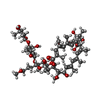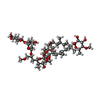+Search query
-Structure paper
| Title | Apoptolidin family glycomacrolides target leukemia through inhibition of ATP synthase. |
|---|---|
| Journal, issue, pages | Nat Chem Biol, Vol. 18, Issue 4, Page 360-367, Year 2022 |
| Publish date | Dec 2, 2021 |
 Authors Authors | Benjamin J Reisman / Hui Guo / Haley E Ramsey / Madison T Wright / Bradley I Reinfeld / P Brent Ferrell / Gary A Sulikowski / W Kimryn Rathmell / Michael R Savona / Lars Plate / John L Rubinstein / Brian O Bachmann /   |
| PubMed Abstract | Cancer cells have long been recognized to exhibit unique bioenergetic requirements. The apoptolidin family of glycomacrolides are distinguished by their selective cytotoxicity towards oncogene- ...Cancer cells have long been recognized to exhibit unique bioenergetic requirements. The apoptolidin family of glycomacrolides are distinguished by their selective cytotoxicity towards oncogene-transformed cells, yet their molecular mechanism remains uncertain. We used photoaffinity analogs of the apoptolidins to identify the F subcomplex of mitochondrial ATP synthase as the target of apoptolidin A. Cryogenic electron microscopy (cryo-EM) of apoptolidin and ammocidin-ATP synthase complexes revealed a novel shared mode of inhibition that was confirmed by deep mutational scanning of the binding interface to reveal resistance mutations which were confirmed using CRISPR-Cas9. Ammocidin A was found to suppress leukemia progression in vivo at doses that were tolerated with minimal toxicity. The combination of cellular, structural, mutagenesis, and in vivo evidence defines the mechanism of action of apoptolidin family glycomacrolides and establishes a path to address oxidative phosphorylation-dependent cancers. |
 External links External links |  Nat Chem Biol / Nat Chem Biol /  PubMed:34857958 / PubMed:34857958 /  PubMed Central PubMed Central |
| Methods | EM (single particle) |
| Resolution | 3.1 - 4.2 Å |
| Structure data | EMDB-23763, PDB-7md2: EMDB-23764, PDB-7md3:  EMDB-23765: |
| Chemicals |  ChemComp-ATP:  ChemComp-MG:  ChemComp-PO4:  ChemComp-ZHD:  ChemComp-ZH7: |
| Source |
|
 Keywords Keywords | HYDROLASE/HYDROLASE INHIBITOR / F1-ATPase / inhibitor / anti-cancer / HYDROLASE / HYDROLASE-HYDROLASE INHIBITOR complex / TRANSLOCASE |
 Movie
Movie Controller
Controller Structure viewers
Structure viewers About Yorodumi Papers
About Yorodumi Papers








